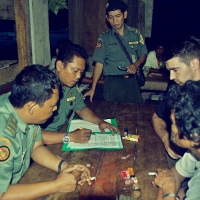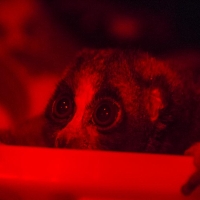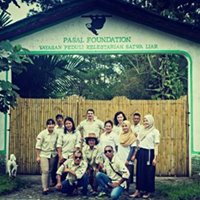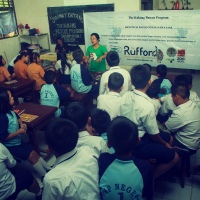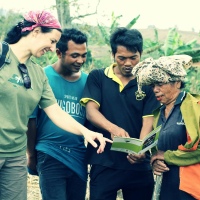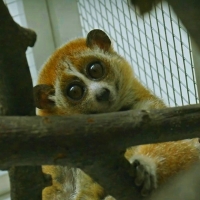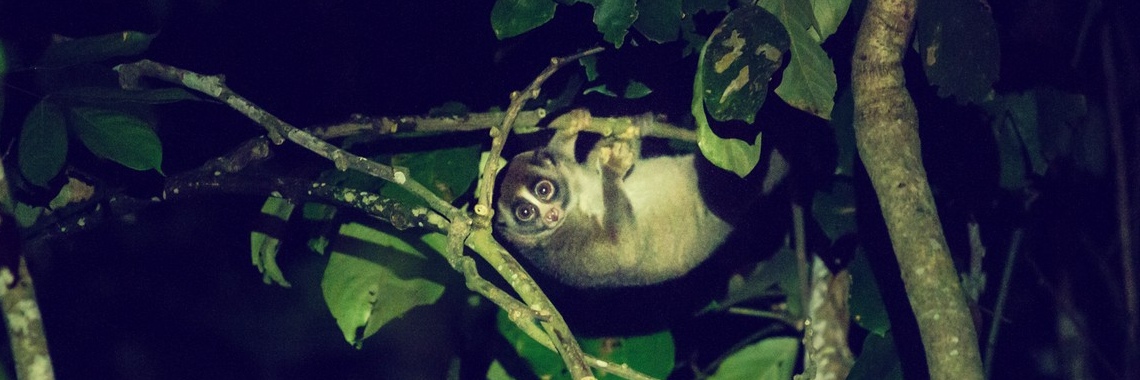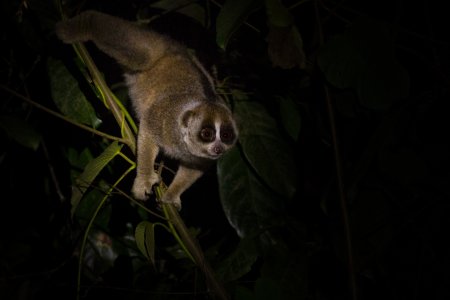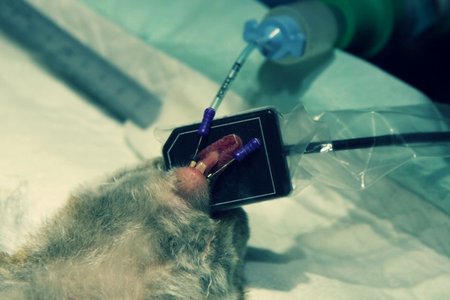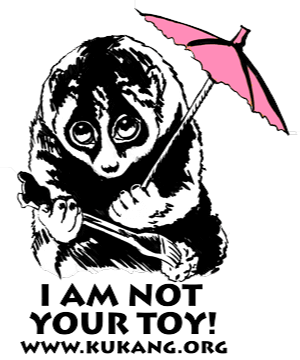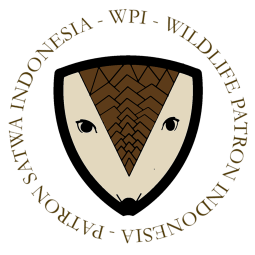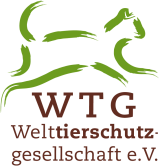Prosimians
Slow lorises (Nycticebus spp.) belong to an evolutionary old group of primates (Primates) – prosimians (Prosimiae). Prosimians differ from simians in many important characteristics, for example, the un-fused mandibular symphysis (two halves of the lower jaw), an orbit missing a lacrimal bone, underdeveloped stereoscopic vision, very well-developed olfaction on the other hand, and territorial scent marking using their scent glands. Prosimians also have relatively small brains compared to simians, with limited or no brain structuring into ridges and a big olfactory part of telencephalon. Prosimians also usually have conspicuous teeth specializations and the number of their teeth might be reduced.
Taxonomy of slow lorises in Sumatra
In 2020, there was a taxonomic division of the species of the greater slow loris (Nycticebus coucang) into two separate species - greater slow loris (Nycticebus coucang) and Sumatran slow loris (Nycticebus hilleri). The area in which we operate can be considered as a border area of the areas of distribution of these two species. As a result, our conservation activities include both species, particularly in the case of confiscated slow lorises accepted to our rescue centre. Slow lorises living in our field area should, according to the definition of the area on the IUCN Red List of Threatened Species, belong to the species of Sumatran slow loris (Nycticebus hilleri). These two species are supposed to differ mainly in the colour of the coat.
Distribution
Greater slow lorises can be found in Indonesia (Sumatra), Malaysia (continental Malaysia), Thailand, and Singapore. Sumatran slow lorises are endemic to the northern part of Sumatra. Lorises inhabit various areas ranging from a primary tropical rainforest, mixed or coniferous tropical forests, marshes, and savanna, to damaged, eroded, or mined forests. Their territory can range from approximately 0.004 km² to 0.25 km², depending on the habitat type.
Greater slow loris (Nycticebus coucang) in its natural environment
Greater slow loris
The greater slow loris (Nycticebus coucang)
Anatomy
According to the current taxonomy, the greater slow loris (Nycticebus coucang) and Sumatran slow loris (Nycticebus hilleri) belong among nine slow loris species. They are animals with a nocturnal activity associated with their conspicuous eyes that give it a brilliant orientation while searching for food at night. Slow loris eyes are big, round, and frontally orientated, which enables their binocular vision. Because their eyes are immobile, they have to turn their head if they want to change the angle of their vision. Most species also possess the so-called tapetum lucidum, which is a reflective layer behind a retina of an eye that provides the animals with brilliant night vision. It also causes the “flashing” eyes you can see at night; their reflection is visible up to several hundred meters. However, slow lorises are almost color-blind and their vision is mostly black-and-white, which is the consequence of their adaptation to the nightlife. Slow lorises have a highly developed olfaction and they prefer communication through scent marking with complex scent glands. Their rhinarium (“wet nose”) allows them to smell various scents with the utmost sensitivity. Slow lorises share many of the same teeth modifications as other prosimians, mainly in molars and premolars. Their cuspids are relatively big and sharp and together with their strong jaws, they can cause a painful bite. Incisors in maxilla are pretty small or missing. On the other hand, incisors of the mandible are long and thin, connected with similar cuspids they form a narrow row, called a “dental comb” that has an important function for grooming and food acquiring. Slow lorises also have a special “sublingual” organ, which is a second tongue used for removing hair and debris from their dental comb.
On the photo, you can see the special sublingual organ, the “second tongue”, and the so-called “dental comb” of the Javan slow loris (Nycticebus javanicus)
Unlike their eyes, their ear lobes are mobile and let them optimize their position according to a sound source. Lorises move relatively slowly by quadruped “sinusoidal” movements on all four legs, while the forelimbs are the same length as the hind limbs. The limbs have opposable thumbs with an unexpectedly firm grip which are perfectly adapted for climbing. The firm grip is an adaptation, enabled by modification of their tendons, muscles, and vascular supply of both front and hind limbs. All fingers end with nails, except the second finger of a hind limb that has a curved grooming claw that all prosimians have in order to be able to brush their fur. Due to their anatomy, lorises cannot jump, but they can hunt their prey surprisingly fast. Slow lorises’ limbs are long but their tail is very short. On the inner side of their elbow, there is an important gland that produces a yellowish and malodorous secretion. This fluid contains a toxin which makes slow lorises the only venomous primates in the world. The toxin is being activated when mixed with saliva. Slow lorises use it to protect themselves or their babies. Mothers rub the toxin into their babies’ fur to protect them when they need to leave them alone. There are records of severe illness or even death following their toxic bites. Their metabolism is very slow, demanding a stable body temperature without swings. It enables them to digest often toxic fruits of plants that they feed on. The stable temperature is ensured by their thick fur that has a brownish or grayish colour with a conspicuous dark stripe on their back. The coloration of their facial features creates the typical slow loris mask (differing in species) which allows us to recognize a particular individual throughout his whole life. Greater and Sumatran slow lorises grow up to 27-38 cm and weigh 599-685 g.
Food
Slow lorises feed on fruit, invertebrates (frequently those with an awful taste and smell for other animals), small vertebrates, fruits, leaves, or bark but also plant resin, sap, and plant nectar which are very important parts of their diet. Resin, as a high energy source also comprises of a high amount of carbohydrates. Slow lorises can digest resin thanks to their large cecum.
The insect is one of the major food sources of slow lorises
Gender and mating
Determining the sex of slow lorises is difficult at first glance, however, males have short, thin penis and females have even shorter and much thinner clitoris. In their time of heat, females usually loudly and periodically “whistle” and mark their territory. A male, if interested, will reply with whistling and “overmarking” the territory marked by the female. Mating usually happens while both lorises hang from a branch. The oestrus lasts 29-45 days, while they can mate throughout the entire year. The gestation period lasts around 191 days resulting in a single (rarely two) grey young with silver-white legs. The young are already well developed when born, their eyes are open and their weight is around 15 g. An interesting fact is that females give birth during the day. Mothers start to regularly leave their offspring alone already from the first day of their lives. They feed them with milk for 2.5 to 6 months and the young can ingest firm food already in the 3rd or 4th week of age. They mature at the age of 6 months but stay with their mothers longer. Females can become sexually active after their 16th month and males in their 18th month. Compared to other mammals of similar size, slow lorises become sexually active relatively late, followed with a long gestation period with low reproductive capability characterized by few offspring and a long interval between gestations.
Behaviour
Slow lorises are active from sunset to sunrise. Most of their time is spent in solitarily looking for food and observing their surroundings. They communicate with each other by hissing, whistling, and the adolescents are able to even use ultrasound if under threat. The main communication method is based on using urine, as they leave urine marks everywhere they go. Slow lorises tend to use the same trails through trees or sometimes even on the ground. Greater slow lorises form a social structure called noyau, which means that smaller territories of females or submissive males are covered by the bigger territory of a dominant male. They regularly sleep in a different location but they sleep in a typical position, having their head hidden between their thighs, curled into a ball. If the surrounding temperature drops, they are able to minimize their movement and fall into a motionless state for up to several days. They main predators are reticulated pythons (Python reticulatus), changeable hawk-eagles (Spizaetus cirrhatus), and orangutans (Pongo pygmaeus). Due to their nocturnal and inconspicuous nature, there is very little known about their lifestyle.
Threats
The biggest threats to slow lorises in Sumatra are black animal markets, where they are sold as “house pets”. Other threats are loss and damage to their habitat to create oil palm (Elaeis guineensis) plantations, illegal wood mines, etc. Slow lorises are also often being shot as crop pests.






